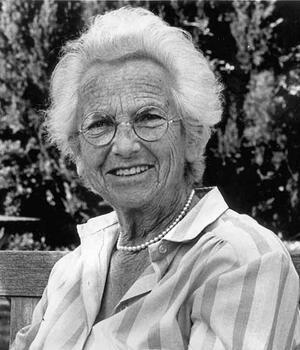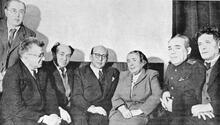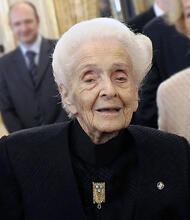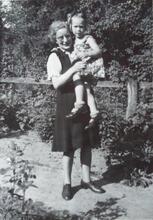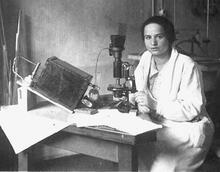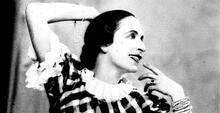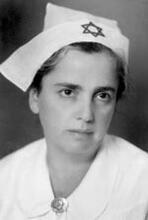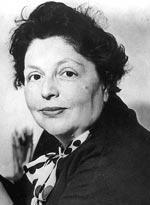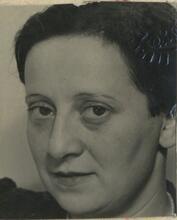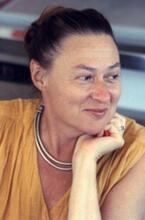Edith Bülbring
At the time of her death, doctor, biologist, and physiologist Edith Bülbring (1903-1990) was widely considered to be the most influential smooth-muscle physiologist in the world. Since then, her scientific "grandchildren" have continued to build on her work in ever new and important ways.
Institution: Dr. W. Hijmans, Aerdenhoot, The Netherlands.
German-born scientist Edith Bülbring was renowned for her work in smooth muscle physiology, which paved the way for contemporary cellular investigations. After losing her post as a physician in Berlin in 1933, Bülbring moved to England and found work as an assistant to J.H. Burn in his laboratories; when he moved to Oxford in 1937, she went with him. In 1950 she began building a large research group at Oxford to study smooth muscle; with Bülbring as its leader, the group published some 200 papers between 1953 and 1970. After Bülbring’s retirement, numerous laboratories around the world took up the subject of smooth muscle, the majority of which were led by Bülbring’s former co-workers.
Edith Bülbring was born in Bonn, the youngest of the four children of Dr. Karl Bülbring, Professor of English at the University of Bonn, and Hortense Leonore Bülbring (née Kahn 1868–1938), the daughter of a distinguished Jewish banker family in The Hague. Hortense’s uncle was the artist Jozef Israels and her brother Jacobus (1872–1944) was, with Theodore Herzl and David Wolfson, a founder of the Jewish Colonial Trust and of the city of Tel Aviv. Jacobus and his wife died in Theresienstadt. Edith’s father Karl was not Jewish.
Education
Edith began her formal education at Easter 1910, at the Klostermann Lyceum, where she continued for ten years, leaving when she was sixteen because the school did not provide education up to university entrance level. After receiving some private tuition, she entered the Bonn Gymnasium at Easter 1922, studying chemistry, physics, and mathematics. A year later she passed her municipal examinations in these subjects, thus qualifying for university entrance.
She entered Bonn University in the summer of 1923, first studying physiology with the intention of eventually studying medicine. She passed her preclinical examination in medicine in July 1925 and then proceeded to Munich, Freiburg, and Bonn for her clinical training. In May 1928, aged 24, she passed her final medical examinations, moving to Berlin to spend a year as house physician at the Westend hospital. Following this, she spent some two years working as an unpaid assistant pharmacologist with Paul Trendelenburg, with whom she had studied in Freiburg and who was now Professor of Pharmacology in Berlin. During this time, she was supported by her bank account and by her banker uncles in The Hague. Remarkably, given her junior position, during this time she published three papers of which she was the sole author, all on quite different subjects.
In 1931, following her mentor Trendelenburg’s death of tuberculosis, she took a post as a pediatrician in Jena, but a year later she returned to Berlin to work in the infectious diseases unit at Virchow hospital, under the immunologist Ulrich Friedemann. Although she at first escaped dismissal with the rise of the Nazi party, because only two of her grandparents were Jewish, she too was dismissed in 1933.
Emigration to England & Collaboration with J.H. Burn
In September 1933 Edith went on holiday to England, with her sister Maud and two friends. In London she again met Friedemann, who had been dismissed from his Berlin post in April 1933 and who suggested she meet Henry Dale, with whom Friedemann was now working in his famous ‘F4’ laboratory in Hampstead. To her surprise, Dale offered her a job in England and recommended her to J.H. Burn, who had recently set up biological standardization laboratories for the Pharmaceutical Society in Bloomsbury Square, and who employed her as his assistant.
Joined in England by her sister Maud, Edith traveled frequently with her to Germany to see their mother, who died in 1938. But she now realized that she was probably destined to spend the rest of her scientific life in England, where she was exposed to a broad spectrum of scientific expertise in the laboratories of the Pharmaceutical Society. During this period, she published papers based on her routine work of biological standardization, but also—more significantly—some which described experiments on vasodilatory fibres in various animal species. It was the latter which had a lasting impact on her scientific development, which subsequently involved the nervous system and control of muscular contraction.
Throughout her early years in England Bülbring collaborated closely with Burn. In 1937, when he was offered the Chair of Pharmacology at Oxford University, he invited Edith to help him set up his laboratories there. She lived in Oxford for the rest of her life, building a beautiful house which she later bequeathed to Lady Margaret Hall, the college where Burn arranged for her to become a member of the Senior Common Room.
Initially appointed to the post of Departmental Demonstrator, which she held for many years, she was promoted to University Demonstrator and Lecturer in 1946.
Between 1940 and 1950 Edith worked with different collaborators, but Burn remained her major collaborator. By far the greater part of her work until 1952 dealt with the actions of adrenaline, of acetylcholine, and with their interrelations. From 1948 on, she published most of her work alone. Indeed, several workers who were attracted to Oxford to work with Burn ended up working with Edith.
Work on Smooth Muscle
In 1949, Edith spent eight months in the U.S., working at Johns Hopkins and lecturing at various universities. Upon her return to Oxford in 1950 she began work on smooth muscle—an area in which she continued for 40 years and in which she did her most distinguished research. Because the publication of her early papers on smooth muscle attracted many visiting workers to Oxford, she was able to build up a large and flourishing research group, for which she successfully raised significant funding.
In the seventeen years beginning in 1953, during which Edith headed the group, its members published over 200 papers, of eleven percent of which Edith was sole author. Some 40 scientists worked with her during this period, only seven of whom were from Britain. Twenty-six of her colleagues were or became chairpersons of their departments, or came to hold personal chairs.
Edith herself received an ad hominem readership at Oxford in 1960 and was promoted to an ad hominem professorship in 1967, before retiring in 1971. In 1958 she had been elected to the Royal Society. She was awarded honorary degrees by universities in Groningen, Leuven, and Homburg Saar. She was awarded the Schmiedeberg-Plakette of the Deutsche Pharmakologische Gesellschaft in 1974 and the Wellcome Gold Medal in Pharmacology in 1985.
. Legacy
After her retirement in 1971, Edith was offered a small laboratory and office in the Physiology Laboratory and for some years continued to do active research. She died after a series of operations, including a leg amputation, on July 5, 1990, at the time of the 11th International Congress of Pharmacology in Amsterdam, where the announcement of her death was made to many of her assembled friends and colleagues from all over the world.
Edith’s contributions to smooth-muscle physiology and pharmacology were immense. After she had seized upon smooth muscle as an area of research, it burgeoned world-wide over a growth phase of about twenty years. At the time of her death, most physiologists and pharmacologists would have acknowledged her as being the most influential smooth-muscle physiologist in the world.
Numerous laboratories around the world took up the subject; the majority were led by former co-workers of Edith who had spent time in her laboratory in Oxford; they were her children and she took as great an interest in their progress as would any parent. In due course, even more numerous scientific “grandchildren” were conceived in these laboratories. Her work and that of her collaborators paved the way for the present era of the single cell and laid the foundations upon which present cellular investigations of smooth muscle are based.
A copy of the full bibliography is available from the Royal Society on request.
The entry has been condensed with permission from:
The Royal Society Biographical Memoir on Edith Bülbring, Volume 38 (1992), pp. 69–95. By T.B. Bolton and A.F. Brading.

